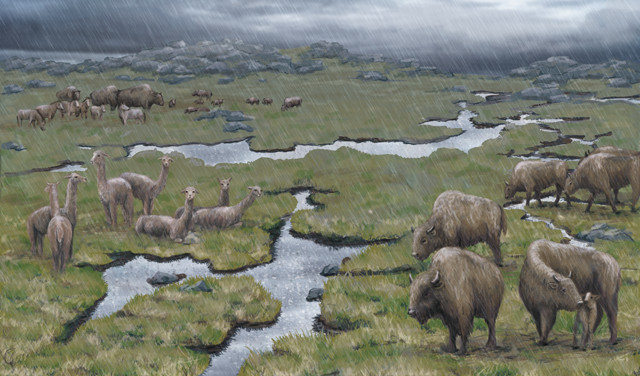
by Mary Caperton Morton Tuesday, August 15, 2017

Large ice-age herbivores, as imagined in this artist's rendition, might have been driven to extinction by rising moisture levels that caused semi-arid grassland areas to shrink. Credit: K. Cantner, AGI.
Between 15,000 and 11,000 years ago, dozens of ice-age megafauna species went extinct. Various causes, from climate-driven habitat changes to overhunting to extraterrestrial impacts, have been cited for these extinctions. But new research looking at fossils of large herbivores such as bison, horses and llama supports the idea that a worldwide uptick in moisture was a main driver of the extinction trend.
As the last ice age came to a close, melting glaciers and thawing permafrost greatly increased atmospheric moisture levels and rainfall in many parts of the world, shrinking the semi-arid grasslands that fed large grazing herbivores. In a study in Nature Ecology and Evolution, scientists examined more than 500 radiocarbon-dated bones from herbivores that lived in Europe, Siberia and the Americas at the end of the Pleistocene. In nitrogen isotopic signatures preserved in bone collagen, they found evidence for a shift in precipitation.
“We didn’t expect to find such clear signals of moisture increases occurring so widely,” said co-author Alan Cooper, director of the Australian Center for Ancient DNA at the University of Adelaide in Australia, in a statement. “The timing [of the increase] varied between regions, but matches the collapse of glaciers and permafrost and occurs just before most species go extinct.”
According to Cooper and his colleagues, the pattern may also help explain why many large herbivores and their predators in Africa at the time were mostly spared: The continent’s central forested belt might have buffered the effects of increased moisture on the surrounding grasslands. Meanwhile, grasslands across North and South America, Europe, and Siberia are thought to have been partly replaced by bogs and peatlands that would not have supported herds of large grazers.
© 2008-2021. All rights reserved. Any copying, redistribution or retransmission of any of the contents of this service without the expressed written permission of the American Geosciences Institute is expressly prohibited. Click here for all copyright requests.